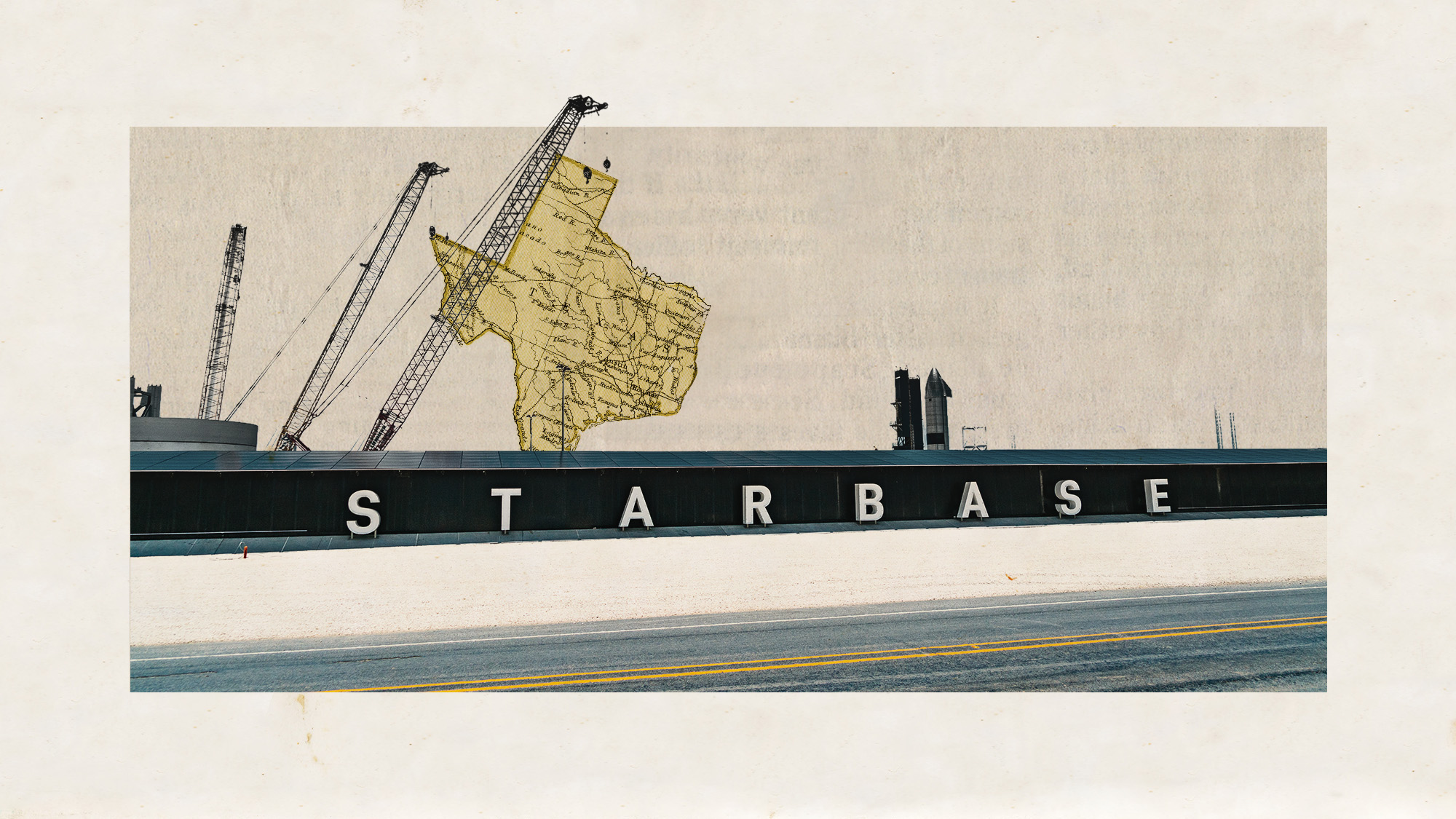SpaceX Starship: manned mission on course for 2020 launch
Elon Musk announces bold testing schedule as huge stainless steel rocket is unveiled
SpaceX founder Elon Musk has revealed the design of the new rocket that will take humans to the Moon and beyond.
Unveiled to the world in a live stream from SpaceX’s launch site in Texas on Saturday, Starship is on course to become the most powerful rocket to date and carry up to 100 people “on long-duration, interplanetary flights”, the company tweeted.
Standing in front of a “giant prototype” version of the stainless steel vessel, Musk told attendees at the event that Starship could make its debut flight in just six months’ time and possibly carry passengers as early as next year, The Verge reports.
The Week
Escape your echo chamber. Get the facts behind the news, plus analysis from multiple perspectives.

Sign up for The Week's Free Newsletters
From our morning news briefing to a weekly Good News Newsletter, get the best of The Week delivered directly to your inbox.
From our morning news briefing to a weekly Good News Newsletter, get the best of The Week delivered directly to your inbox.
“This thing is going to take off, fly to 65,000 feet – about 20 kilometres – and come back and land in about one to two months,” said Musk.
Once the rigorous testing programme is complete, SpaceX will aim to use Starship to “carry crew and cargo to the Moon, Mars or anywhere else in the solar system” and safely return to Earth, says The Guardian.
What is SpaceX’s Starship?
Starship is arguably SpaceX’s “most ambitious vehicle concept yet”, as the company intends to use the rocket to transport cargo and humans to the Moon and Mars, The Verge reports.
A free daily email with the biggest news stories of the day – and the best features from TheWeek.com
Like the company’s other rockets, the Falcon 9 and Falcon Heavy, Starship has been designed to be “fully reusable”, the tech site says. This means the rocket can be landed in one piece, then be serviced and have any worn parts replaced before being sent on another mission.
Design
Described by The New York Times as a “giant, shiny and pointy grain silo”, the vessel unveiled during the live stream was a prototype version of Starship – though it closely resembles concept drawings posted by Musk earlier this year.
The rocket’s most distinct feature is its reflective outer surface. The skin is constructed from stainless steel, as opposed to carbon fibre that’s commonly used in the aerospace world, the BBC reports.
Musk elected to use the lightweight metal, which also performs well in extremely high and low temperatures, in a bid to keep costs down, the broadcaster notes. Steel costs $2,500 (£1,950) per tonne, while carbon fibre is $130,000 (£105,600) per tonne.
The four fins, two at the front and two at the rear, are designed to help maintain balance when re-entering Earth’s atmosphere, the BBC adds.
Powering the Starship prototype, which stands 50 metres high - excluding the booster stage, are three “next-generation” Raptor engines attached to the rocket’s base, says The Verge. The engines are activated during the ascent phase and to gently bring the vessel back to Earth during its descent.
How is it different to the Crew Dragon?
The Crew Dragon is the company’s first manned vehicle and is expected to make its first voyage with a pair of astronauts onboard by “no earlier” than 15 November, according to tech news site Teslarati.
Based on the Dragon cargo vessel, the Crew Dragon is a small capsule that can carry up to seven occupants and is launched into orbit aboard one of the company’s Falcon 9 rockets.
Starship, meanwhile, will be able to carry up to 100 people at once, the Daily Express reports. This would make it by far the largest rocket ever created.
It’s powered by a “monstrous booster stage” that is equipped with 41 Raptor rocket engines, says the newspaper. That’s significantly more than the 27 Merlin engines that power SpaceX’s Falcon Heavy, currently the most powerful rocket in the company’s fleet
When will tests begin?
Testing is already well under way, as SpaceX has been trialling a single-engine test mule – known as Starhopper – since March.
However, testing of the full-scale prototype unveiled on Saturday will begin “within a month or two”, says the New York Times. During this testing, the rocket will travel 12 miles vertically before landing “in one piece”.
In six months’ time, SpaceX hopes to launch the rocket into orbit using the rocket booster assembly of its existing Falcon Heavy craft, the newspaper says.
As for a manned mission, Musk told the paper: “I think we could potentially see people flying next year.”
What about the first mission?
Initially, SpaceX will use Starship to transport paying tourists into orbit. The company named Japanese billionaire Yusaku Maezawa and his eight chosen guests as the first customers of the programme, and intends to send them into space in 2023, Business Insider reports.
Musk hopes Starship can be used to transport humans and cargo to Mars over the next few years, with the aim of establishing the early foundations of a colony on the red planet by 2025, says Inverse.
-
 Inside Minnesota’s extensive fraud schemes
Inside Minnesota’s extensive fraud schemesThe Explainer The fraud allegedly goes back to the Covid-19 pandemic
-
 ‘What a corrective to such nonsense’
‘What a corrective to such nonsense’Instant Opinion Opinion, comment and editorials of the day
-
 TikTok secures deal to remain in US
TikTok secures deal to remain in USSpeed Read ByteDance will form a US version of the popular video-sharing platform
-
 Inside a Black community’s fight against Elon Musk’s supercomputer
Inside a Black community’s fight against Elon Musk’s supercomputerUnder the radar Pollution from Colossal looms over a small Southern town, potentially exacerbating health concerns
-
 X update unveils foreign MAGA boosters
X update unveils foreign MAGA boostersSpeed Read The accounts were located in Russia and Nigeria, among other countries
-
 What's Linda Yaccarino's legacy? And what's next for X?
What's Linda Yaccarino's legacy? And what's next for X?Today's Big Question An 'uncertain future' in the age of TikTok
-
 X CEO Yaccarino quits after two years
X CEO Yaccarino quits after two yearsSpeed Read Elon Musk hired Linda Yaccarino to run X in 2023
-
 Musk chatbot Grok praises Hitler on X
Musk chatbot Grok praises Hitler on XSpeed Read Grok made antisemitic comments and referred to itself as 'MechaHitler'
-
 Another Starship blast sets back Musk's Mars hopes
Another Starship blast sets back Musk's Mars hopesSpeed Read Nobody was killed in the explosion, which occurred in south Texas
-
 What Elon Musk's Grok AI controversy reveals about chatbots
What Elon Musk's Grok AI controversy reveals about chatbotsIn the Spotlight The spread of misinformation is a reminder of how imperfect chatbots really are
-
 Elon Musk's SpaceX has created a new city in Texas
Elon Musk's SpaceX has created a new city in TexasUnder The Radar Starbase is home to SpaceX's rocket launch site